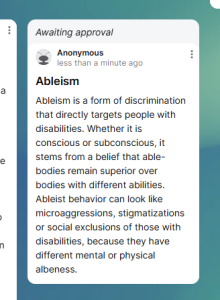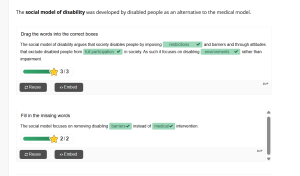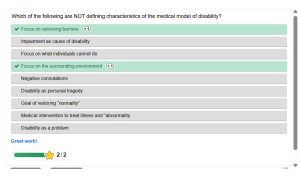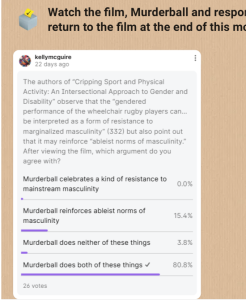5 Chapter 5 (Completed)
Padlet and Activity Screenshots:






Notebook Question Answers:
The authors also observe that “Ableism not only intersects with other forms of oppression, such as racism, sexism, ageism, and classism, but abilities are often used to justify such negative ‘isms’.” What do you think this means? Provide an example.
I think this passage is referring to intersectionality, which suggests that people are much more likely to be discriminated against if they identify with numerous marginalized groups. An example of this could be if a Black disabled child is excluded from sports in gym class based on abilities, but also socially excluded by the other children due to racism. There are multiple factors that can play into the discrimination that is imposed onto others through stigmas and the upheld societal superiority of able bodies, especially white, male and cisgendered ones.
Did anything surprise you about the results of the test? Please share if you’re comfortable OR comment on the usefulness of these kinds of tests more generally.
I was surprised that my results leaned more towards favoring abled-bodies. I do feel pretty neutral about communicating with abled-bodies or not, but I am a pretty introverted person in general. I excepted this test to be a line of questions, but the activity really jumbled my brain. Because it started with associating ‘Good’ with ‘Physically-abled’ and then reversed to ‘Good’ and ‘Physically-disabled’ it really threw me off. I feel like this shift in rules creates a bias to our actual beliefs, but I think these tests can be useful in conveying how society typically associates good attributes to able-bodied people and bad ones to disabled people.
What do Fitzgerald and Long identify as barriers to inclusion and how might these apply to sport in particular?
For those with disabilities, barriers to inclusion can be through “inaccessible transport, buildings and amenities, lack of opportunity and prejudicial attitudes.” (Fitzgerald and Long, p. 128). The inaccessible spaces can translate to playing fields/areas (or transportation to them) that are not mindful and inclusive of disabled people. The lack of opportunities in sports for disabled athletes tends to be due to discriminatory behaviors and beliefs, as well. These barriers may also be instated subconsciously or ignorantly due to the overarching belief that abled-bodied withhold superiority. Because of this, there may also be social exclusion that occurs among a disabled individual with their fellow teammates too.
Choose ONE of the three questions Fitzgerald and Long argue disability sport needs to address and record your thoughts in your pressbook. 1. Should sport be grouped by ability or disability?
I find that this is an extremely difficult question that unfortunately has no straightforward answer or solution. This is extremely complex because there are advantages and disadvantages by being grouped based on ableness.
On one hand intermingling teams based on abilities can make sports more accessible to travel to and participate in for disabled people. Disabled sports leagues are likely to be far and few between, which creates barriers to playing.
On the other hand, not all people classified as ‘disabled’ want to identify as that and typically people want to play with others on the same level of abilities. Especially when it comes to competitive sports.
While playing on a team of mostly able-bodies can be empowering for disabled people, it may also be discouraging to play with non-disabled people.
This is why I think that reverse-integration is the best approach, even though it is not all encompassing. It seems effective because it removes the strict barriers of ability versus disability and instead focuses on blurring these lines by grouping fully able folks with athletes who have minor disabilities. I think this integration process can allow for disabled people to have more agency, feel included and reduce stigmatizations among society.
1) Do you agree with the critique of the “supercrip” narrative in this video? Why or why not? Find an example of the “supercrip” Paralympian in the 2024 Paris Paralympics or Special Olympics coverage and explain how it works.
Yes, I would have to say I agree with the supercrip critique, which raises points I hadn’t considered prior to reading the blog. The “We’re the super humans” ad can be empowering to para-athletes and encouraging for people with similar disabilities, but it can also negatively reinforce ableism on people with less abilities than them. Even just existing with a difficult and complex disability is worth praise, because it takes strength to pull through hard times. But, it seems like this ad could make disabled people feel like they have to do extraordinary things to be worthy of attention or admiration from others.
In Murderball and this blog, it was mentioned that there is commonly embarrassment among para-athletes for being mistakenly associated to the Special Olympics. Even within the demographic of disabled people, there can be ableism reflected upon other disabilities which make speech, cognitive or physical movement extremely difficult or not possible.
I found a YouTube short that gave coverage to the 2024 Paralympics in Paris: https://youtube.com/shorts/akq0Q7ny8zg?si=kdp4kJ6_vILEu83N
This initially caught my attention because I the first quickly line goes, “I bet you didn’t know that the Paris 2024 Paralympics were packed with jaw-dropping moments!” before touching on some of the highlights. I felt like this is kind of a backhanded remark that insinuates that the Paralympics wouldn’t be as riveting to watch as able-bodied sports. I think the rest of the video did a great job of bringing awareness to some monumental moments, but the introduction felt like an ableist microaggression.
2) Does the film Murderball play into the supercrip narrative in your opinion? How does gender inform supercrip (read this blog for some ideas)?
Yes, I would say this film plays into the supercrip narrative and hyper focuses on stereotypical masculinity. As mentioned within the blog attached to this question, the disabled people who are highlighted in sports tend to be white and cis-gendered men such as in Murderball. I think it is important to still acknowledge the privileges that come with that, such as media representation. As for their physical attributes they are muscular and attractive with mental attributes of being strong willed and aggressive. This creates “inspiration porn” for disabled people and it can make them feel inadequate with themselves as they are.
In Murderball, there is an emphasis on the male gender. I think the times are reflected here, because in there were no female rugby teams in the Paralympics of the early 2000’s, but there are now. As for how women are represented in this film, it is as supporting girlfriends and family, or sex objects. A comment that felt unnecessary to include is when on rugby player says he “doesn’t like big tits” and that it doesn’t mean he secretly likes men. It reinforces the male gaze, puts down women and promotes homophobic ideologies. It shows how toxic masculinity was encouraged and normalized for these disabled white cis-gender men to feel ‘normal’ again after their accidents or diseases.
Media Attributions
- mod5padlet
- mod5activity3
- mod5acitivity2
- mod5activity1
- mod5acitivity4
- Screenshot 2025-03-27 132827
